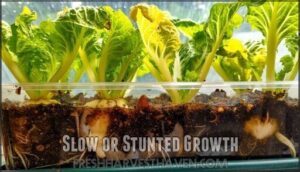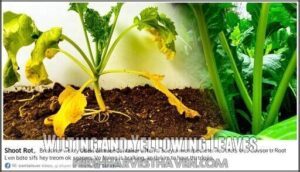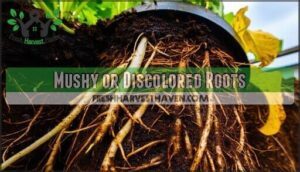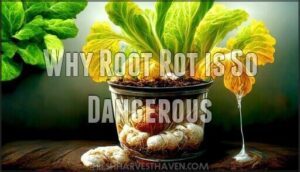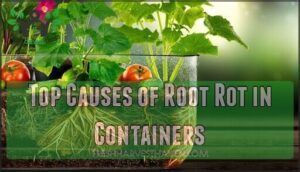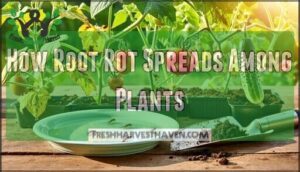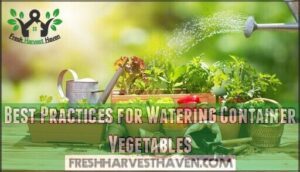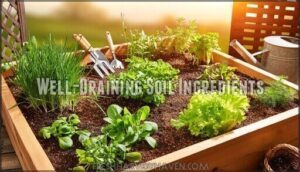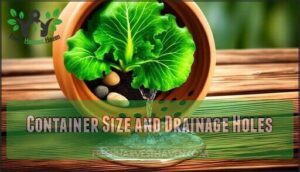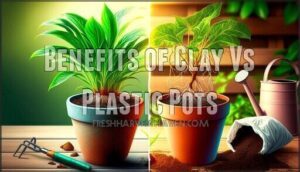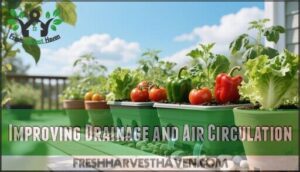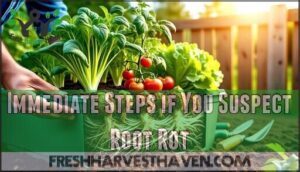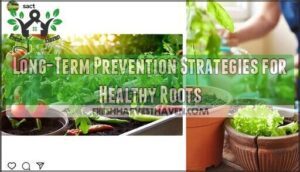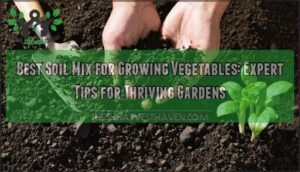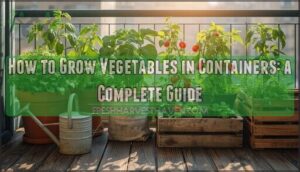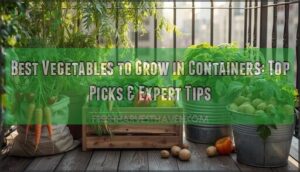This site is supported by our readers. We may earn a commission, at no cost to you, if you purchase through links.
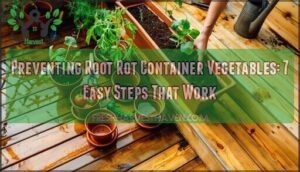
Overwatering creates oxygen-starved soil where harmful fungi like Pythium thrive, turning healthy roots into mushy disasters.
Check soil moisture by sticking your finger two inches deep—if it’s wet, wait.
Use well-draining potting mix with perlite or vermiculite, make certain containers have drainage holes, and elevate pots for better airflow.
Allow soil to dry between waterings, which starves fungi of their favorite saturated conditions.
Root rot spreads fast in containers, so sterilize tools and avoid sharing water between plants.
Early detection saves plants—watch for yellowing leaves and stunted growth before it’s too late.
This approach helps in preventing root rot and ensures healthy plant growth.
Table Of Contents
- Key Takeaways
- What is Root Rot in Container Vegetables
- Early Signs of Root Rot to Watch For
- Why Root Rot is So Dangerous
- Top Causes of Root Rot in Containers
- How Root Rot Spreads Among Plants
- Best Practices for Watering Container Vegetables
- Choosing The Right Potting Mix and Containers
- Improving Drainage and Air Circulation
- Immediate Steps if You Suspect Root Rot
- Long-Term Prevention Strategies for Healthy Roots
- Frequently Asked Questions (FAQs)
- How to prevent root rot in planters?
- How to cure root rot in potted plants?
- How to avoid root rot in seedlings?
- How do you prevent root rot in containers?
- What potting mix prevents root rot?
- How do you treat root rot in a vegetable garden?
- How do you prevent root rot in potted plants?
- Does cinnamon stop root rot?
- Does hydrogen peroxide stop root rot?
- Can root rot spread between different vegetable plants?
- Conclusion
Key Takeaways
- Master moisture control: Check soil 2 inches deep with your finger—if it’s wet, don’t water. Let the top soil dry completely between waterings to starve harmful fungi of the saturated conditions they need.
- Use well-draining potting mix: Mix 30-50% perlite or vermiculite into your soil and ensure containers have proper drainage holes. Elevate pots for better airflow and faster drying.
- Practice strict hygiene: Sterilize tools with rubbing alcohol between plants and avoid sharing water or soil between containers. Clean pots thoroughly with a bleach solution before reusing.
- Watch for early warning signs: Yellow leaves and stunted growth signal root rot before it’s fatal. Act fast by inspecting roots—healthy ones are firm and white, while infected roots turn brown and mushy.
What is Root Rot in Container Vegetables
Root rot occurs when your container vegetables’ roots decay due to waterlogged soil that starves them of oxygen, creating perfect conditions for harmful fungi like Pythium and Fusarium to attack.
This sneaky plant killer can destroy healthy vegetables within weeks, often before you notice any warning signs above ground, which is a condition that can be described as a perfect environment for the fungi to thrive.
Definition and Causes
Root rot strikes when waterlogged soil creates oxygen deprivation, suffocating your vegetable roots.
Waterlogged soil suffocates vegetable roots, creating perfect conditions for deadly fungal attacks
This deadly condition allows fungal proliferation as harmful fungi types like Pythium and Fusarium thrive in saturated environments.
Without proper soil drainage, overwatering symptoms quickly develop as root suffocation prevents nutrient absorption, making container vegetable care and root rot prevention absolutely critical for healthy plants.
Impact on Vegetable Growth
Once root rot takes hold, your container vegetables face a domino effect of problems.
Yield reduction becomes inevitable as damaged roots can’t absorb nutrients properly, creating nutrient deficiency that stunts development.
Your tomatoes won’t reach full size, and lettuce leaves turn pale yellow. Fruit quality suffers dramatically—what you do harvest lacks flavor and nutritional value.
Without proper root rot prevention and container vegetable care, plant survival drops to nearly zero. Prevention includes improving soil drainage to combat this issue.
Common Fungi Responsible
Beyond just waterlogged conditions, specific fungal diseases target your container vegetables’ roots.
Pythium species attack first in saturated soil, while Phytophthora impact spreads rapidly through contaminated water.
Fusarium survival extends for years in old potting mix, and Rhizoctonia spread thrives in compacted media.
Fungal identification helps you tackle each threat effectively.
Early Signs of Root Rot to Watch For
Catching root rot early can save your vegetable plants from certain death, but the first signs are surprisingly subtle.
You’ll notice slow growth and slightly yellowing leaves weeks before the obvious symptoms like mushy roots appear.
Slow or Stunted Growth
That subtle change in growth rate might be root rot’s earliest warning sign.
When container vegetables aren’t thriving despite proper environmental factors and nutrition, oxygen-starved roots often can’t absorb nutrients efficiently.
This mimics nutrient deficiency symptoms, making diagnosis tricky.
Unlike rootbound symptoms where plants outgrow containers, root rot silently sabotages growth from within, preventing proper drainage and nutrient uptake essential for container gardening success.
Wilting and Yellowing Leaves
If stunted growth wasn’t alarming enough, wilting and yellowing leaves should raise red flags in container gardening.
These symptoms indicate severe loss of turgor pressure as damaged roots fail nutrient absorption. Disease mimicry complicates diagnosis since leaf discoloration resembles nutrient deficiency:
- Early severity stages: Older leaves yellow first, especially near soil
- Progressive wilting: Occurs despite adequate watering techniques
- Advanced symptoms: Leaves become mushy, brown, and drop
Root rot in well-draining soil situations creates confusing plant health signals.
Mushy or Discolored Roots
While yellowing leaves signal problems above ground, you’ll find the real damage beneath the soil surface.
Healthy roots appear firm and white, but root rot transforms them into mushy, brown masses with a foul odor.
These discolored roots can’t absorb nutrients or water, creating severity stages from minor browning to complete root system collapse.
Check your pot drainage holes regularly—proper drainage prevents this devastating root texture deterioration that kills container vegetables.
Why Root Rot is So Dangerous
Root rot strikes fast in container vegetables, often killing healthy plants within weeks before you notice any above-ground symptoms.
By the time leaves start yellowing or wilting, the damage is usually severe and sometimes irreversible, which can be a result of root rot.
Rapid Progression in Containers
Container vegetables face accelerated root rot because confined spaces trap moisture and create perfect breeding grounds for fungi.
Unlike garden plants with unlimited soil drainage, potted vegetables can’t escape waterlogged conditions.
Poor pot drainage holes and inadequate well-draining soil worsen the problem.
Proper watering becomes critical since containers concentrate moisture levels around healthy roots, making quick spread inevitable in these confined spaces, leading to a critical situation.
Fatality Before Visible Symptoms
By the time you notice wilting leaves or yellowing foliage, root rot has likely already delivered a fatal blow to your container vegetables.
Root rot strikes silently—by the time leaves wilt, your vegetables are already dying
This Hidden Threat operates as a Silent Killer, causing Unseen Damage that progresses rapidly beneath the soil surface.
Your plant’s roots may experience complete Rapid Decline while appearing healthy above ground, making these Missed Signals particularly dangerous for overwatering situations.
Misdiagnosis and Its Risks
Something isn’t right when yellowing leaves lead you down the wrong path.
Misdiagnosis tricks many gardeners into worsening conditions through incorrect treatments, creating treatment delays that cause irreversible harm and complete plant loss.
Root rot symptoms mirror other plant problems, making accurate diagnosis essential:
- Hidden damage – Root rot progresses silently while you treat surface symptoms
- Wrong solutions – Overwatering "drought-stressed" plants accelerates decay
- Spreading pathogens – Undetected infections contaminate other containers through shared tools
- Economic losses – Up to 50% yield reduction occurs when root rot goes undiagnosed.
The primary cause is often poorly drained soils.
Top Causes of Root Rot in Containers
You’ll encounter root rot when specific environmental conditions create the perfect storm for fungal growth in your containers.
Understanding these primary causes helps you recognize risk factors before they destroy your vegetable crops.
Overwatering and Poor Drainage
You’re the villain in your vegetable garden’s drama when you overwater your containers.
Excessive watering creates waterlogged soil that suffocates roots, blocking oxygen they need to survive.
Poor drainage compounds this problem by trapping water around root zones.
Without proper drainage solutions and mindful watering habits, you’re creating perfect conditions for root suffocation and fungal growth.
Soil Compaction Issues
Dense soil acts like a concrete blanket over your vegetable roots, choking off the oxygen they desperately need.
When soil particles pack tightly together, water can’t drain properly, creating perfect conditions for root rot fungi to thrive.
Compaction Prevention strategies for healthy root growth:
- Choose well-draining soil with 30-50% perlite or vermiculite to maintain proper soil composition and prevent waterlogging
- Select appropriate container choice – avoid oversized pots that hold excess moisture around root zones
- Practice gentle watering techniques to prevent soil settlement and maintain drainage pathways
- Implement regular soil aeration by gently loosening the top inch monthly without disturbing roots
- Monitor drainage improvement by ensuring water flows freely from container holes within minutes of watering
Cool Temperatures and Saturated Media
Winter conditions create perfect storms for root rot development.
Cool temperatures below 65°F slow water evaporation and plant metabolism, while saturated media restricts oxygen deprivation around roots.
This combination promotes fungal growth in container material, regardless of watering frequency.
Poor drainage compounds the problem, making soil moisture levels dangerously high for extended periods, triggering plant diseases that devastate root systems, leading to root rot development and oxygen deprivation.
How Root Rot Spreads Among Plants
Understanding how root rot spreads between your container vegetables helps you stop this destructive disease before it wipes out your entire garden.
Root rot fungi travel through contaminated water, infected soil, dirty tools, and even tiny fungus gnats that hop from plant to plant, spreading destructive disease.
Water-Borne and Soil-Borne Fungi
Root rot fungi thrive in waterlogged containers, spreading through spore survival in dormant soil and contaminated irrigation water.
These disease vectors – including Pythium, Phytophthora, and Fusarium – can remain viable for months, waiting for perfect conditions.
When soil moisture levels stay consistently high, these plant diseases explode into action.
Fungal identification becomes critical since spores travel easily between your containers through shared water sources, creating devastating fungal impacts on plant roots across your entire garden.
Contaminated Tools and Pots
Your pruning shears can become silent carriers of fungal spores between plants.
Tool sterilization with rubbing alcohol prevents cross-contamination and stops disease transmission.
Clean containers thoroughly before reusing them – fungal persistence in old pots creates perfect conditions for plant diseases.
Proper pot sanitation eliminates hidden threats lurking in container crevices, protecting your vegetables from preventable infections.
Fungus Gnats and Shared Water
How can you protect your container vegetables when those tiny fungus gnats become unwitting accomplices in root rot transmission? These seemingly harmless pests carry waterborne pathogens through their gnat lifecycle, making larval transmission a serious concern for plant diseases prevention.
- Larval Stage Damage: Gnat larvae feed on organic matter and damaged roots, creating entry points for fungal infections
- Shared Water Risks: Bottom-watering multiple containers with the same water spreads contaminated spores between plants
- Adult Gnat Movement: Flying adults transfer fungal spores on their bodies from infected to healthy plants
- Gnat Control Strategy: Use yellow sticky traps and avoid overwatering to break the cycle and improve drainage
Best Practices for Watering Container Vegetables
Proper watering practices form the foundation of root rot prevention in container vegetables.
You’ll need to master moisture management techniques that balance your plants’ hydration needs with the oxygen requirements of their root systems.
Checking Soil Moisture Levels
Accurate moisture assessment prevents overwatering disasters that kill container vegetables within weeks.
The finger test method involves inserting your index finger 2 inches deep into soil—if it feels dry, it’s time to water.
Moisture meters provide precise readings but require calibration for different soil types.
| Method | Accuracy Level |
|---|---|
| Finger Test | Reliable for most situations |
| Moisture Meter | High precision with proper calibration |
| Visual Cues | Moderate reliability |
Professional growers combine multiple techniques for superior plant care.
Visual cues like soil surface color changes supplement physical testing methods.
Consistent soil depth checking at the same 2-inch level guarantees accurate watering frequency decisions and prevents root rot development.
Allowing Soil to Dry Between Waterings
Once you’ve checked soil moisture, you’ll need patience for ideal dryness.
Allow the top 2 inches of soil to dry completely between waterings – this typically takes 3-7 days depending on environmental impact, soil type, and plant sensitivity.
Container vegetables actually thrive with this "drought stress" approach.
Rushed watering frequency prevents root rot by starving harmful fungi of the saturated conditions they need to multiply and damage your plants, which is a key factor in maintaining plant health.
Avoiding Waterlogged Saucers
Standing water in saucers creates perfect breeding grounds for root rot fungi.
Empty saucers within 30 minutes after watering to prevent waterlogged conditions.
Consider saucer alternatives like pot feet for proper elevation, or use drainage solutions that allow excess water to escape completely.
Your watering schedule means nothing if potted plants sit in stagnant water below.
Choosing The Right Potting Mix and Containers
Your potting mix and container choices can make or break your vegetable garden’s success.
The right combination prevents waterlogged roots while providing the drainage and aeration your plants desperately need to thrive.
Well-Draining Soil Ingredients
Your soil mix makes or breaks your container vegetables’ root health. Smart amendments create the fast-draining environment roots need to thrive, preventing deadly root rot from taking hold.
Build your perfect growing medium with these proven ingredients:
- Coconut coir benefits: Retains moisture while improving drainage, creating ideal conditions for vegetable garden tips success
- Perlite ratio: Mix 30-50% perlite for ideal porosity and well-draining soil structure
- Vermiculite uses: Enhances aeration and prevents soil compaction in rootbound plants
- Bark amendments and pumice advantages: Boost drainage speed by 35%, perfect for raised bed gardening applications
These materials prevent waterlogged conditions that suffocate roots and promote fungal growth. Sterilizing your mix prevents disease introduction.
Container Size and Drainage Holes
Choosing the right pot size prevents root congestion while ensuring adequate drainage material flow.
Your container should be 1-2 inches wider than the root ball, with at least one drainage hole per 12 inches of pot diameter.
Proper drainage is essential, and you can find various drainage solutions to help.
| Container Factor | Root Rot Prevention |
|---|---|
| Pot Size | Prevents waterlogged soil around roots |
| Hole Size | Allows excess water to escape quickly |
| Container Material | Affects drying speed and aeration |
| Root Congestion | Reduces water circulation in well-draining soil |
| Drainage Material | Keeps holes clear for proper watering schedule |
Benefits of Clay Vs Plastic Pots
Clay pots offer superior moisture regulation, reducing root rot risk by 40% compared to plastic containers.
Their porous walls improve aeration and temperature stability, supporting healthier root development.
While plastic pots cost 50% less and provide portability, they retain excess moisture and heat faster.
Considering material sourcing options is essential for gardeners.
For root rot prevention, clay’s natural drainage properties outweigh plastic’s convenience benefits, providing superior moisture regulation, and supporting healthier root development, which is a key factor in preventing root rot.
Improving Drainage and Air Circulation
Good drainage and air circulation work together to prevent the waterlogged conditions where root rot fungi thrive.
You’ll need to create an environment where excess water drains quickly and oxygen reaches your vegetable roots consistently, ensuring good drainage and air circulation.
Elevating Containers for Airflow
Boosting your containers just 2-3 cm creates improved airflow beneath pots, reducing saturation by 25%.
Pot feet benefits include enhanced root zone aeration and faster soil drying.
Material choice impact varies—unglazed clay naturally promotes air circulation through porous walls.
Consider using specialized supports for pots to further improve drainage.
This simple elevation trick prevents waterlogged conditions that fuel disease control problems in your welldraining soil mix, promoting better soil health.
Aerating Soil Regularly
Beyond positioning your containers, you’ll want to break up compacted soil regularly.
Use a simple fork or chopstick to gently pierce the surface, creating air pockets that boost oxygen flow to roots.
This soil aeration benefits vegetable growth by preventing waterlogged conditions where harmful fungi thrive.
Aerate monthly or when you notice water pooling on top instead of absorbing quickly, which helps prevent waterlogged conditions and promotes healthy vegetable growth.
Avoiding Rocks and Pebbles in Pots
Skip the old gardening advice about adding rocks to pot bottoms.
Research shows this creates a perched water table that actually traps moisture near roots, increasing root rot risk by 25%.
The rocks block proper water circulation and soil aeration, creating perfect conditions for harmful fungi.
Instead, use quality potting mix with adequate drainage holes for healthy container design and ideal moisture control.
Immediate Steps if You Suspect Root Rot
When you suspect root rot in your container vegetables, immediate action can save your plants before the infection becomes fatal.
Swift diagnosis and treatment within the first few days dramatically increases your chances of recovery, as healthy white roots can still absorb nutrients while damaged brown sections continue spreading through the root system, which is a critical process because healthy white roots are essential.
Inspecting Roots for Damage
First, carefully unpot your container vegetable and gently shake off excess soil to expose the root system for Root Inspection.
Healthy roots appear firm and white, while damaged ones show clear Damage Signs like dark brown or black coloration, mushy texture, and foul odors indicating Fungal Detection.
Examine the entire root ball systematically, checking for soft, slimy areas that signal advanced root rot requiring immediate Root Pruning intervention.
Washing and Pruning Affected Roots
Start by washing away soil remnants under lukewarm running water—this reveals the full extent of damage.
Soak roots briefly to ease inspection, then use sterilized pruning shears for root cleaning.
Cut all mushy, dark tissue well into healthy areas using proper pruning techniques.
Sterilize tools between cuts to prevent fungal treatment complications.
This preventative plant care step requires thorough root inspection before drainage improvements.
Proper root washing techniques are essential for healthy plant establishment and require careful attention to root washing.
Repotting in Fresh Soil
After root pruning, you’ll need fresh, sterile soil for healthy transplanting.
Choose a well-draining potting mix with perlite or vermiculite—your plant’s roots need oxygen, not a swimming pool.
Clean your container thoroughly with diluted bleach for pot sanitizing.
This soil replacement prevents reinfection from lingering fungi.
Remember: drainage holes are non-negotiable for successful repotting and future plant care.
Proper soil preparation techniques are essential for preventing root rot and ensuring healthy plant growth.
Long-Term Prevention Strategies for Healthy Roots
Beyond immediate root rot treatment, you’ll need consistent prevention habits to keep your container vegetables thriving long-term.
These ongoing strategies create an environment where healthy roots can flourish while fungal pathogens struggle to establish themselves, allowing for consistent growth and development.
Routine Monitoring and Maintenance
Looking beyond immediate root rot treatment, you’ll want to establish consistent plant maintenance routines.
Weekly soil checks help catch moisture imbalances early, while monthly root inspections reveal hidden problems before they spread.
Keep a simple water scheduling system, noting each plant’s specific needs.
Regular plant pruning removes stressed foliage that attracts fungi.
Good air circulation around containers prevents mold buildup, making your root rot prevention efforts truly effective.
Sterilizing Tools and Containers
Clean equipment prevents fungal spores from spreading between your vegetable plants. Think of it as washing your hands before surgery—proper tool sanitizing and container disinfection create a sterile environment for healthy root development.
Follow these equipment cleaning steps:
- Tool Sanitizing: Wipe pruning shears and shovels with 70% rubbing alcohol between plants
- Container Disinfection: Scrub pots with bleach solution (1:10 ratio) before replanting
- Soil Sterilization: Bake potting mix at 180°F for 30 minutes to eliminate pathogens
This pot decontamination routine stops mold prevention issues before they start. Understanding container gardening basics is essential for maintaining a healthy and thriving vegetable garden.
Avoiding Soil and Water Sharing Between Plants
Never share potting soil between containers, as dormant fungal spores can survive for months in contaminated media.
Each plant needs its own water source—bottom-watering multiple vegetables with shared water spreads root rot like wildfire.
Practice plant segregation by isolating new additions for two weeks.
Regular soil checks help catch moisture problems early, while proper fungus control prevents devastating losses in your container garden.
Frequently Asked Questions (FAQs)
How to prevent root rot in planters?
Make proper drainage with holes, use well-draining soil mixed with perlite, empty saucers after watering, and let soil dry between waterings to prevent waterlogged conditions.
How to cure root rot in potted plants?
Remove your plant from its pot and inspect the roots.
Cut away all brown, mushy, or foul-smelling roots with sterilized scissors.
Rinse remaining healthy roots and repot in fresh, well-draining soil immediately.
How to avoid root rot in seedlings?
Treat seedlings like delicate newborns—they can’t handle waterlogged conditions.
Use well-draining potting mix with perlite, water only when topsoil dries, make certain drainage holes exist.
Provide adequate airflow around containers.
How do you prevent root rot in containers?
Use well-draining potting mix with perlite, choose containers with drainage holes, water only when top soil feels dry, and elevate pots to improve airflow around roots.
What potting mix prevents root rot?
Potting mixes with 30-50% perlite drain water effectively, preventing waterlogged conditions that kill roots.
You’ll want well-draining substrates combining coconut coir, bark, and vermiculite—these materials create air pockets that roots desperately need to breathe and thrive, ensuring the presence of air pockets.
How do you treat root rot in a vegetable garden?
Root rot spreads quickly through waterlogged soil, so you’ll need to act fast. Remove affected plants, improve drainage with raised beds or containers, and replace contaminated soil completely.
How do you prevent root rot in potted plants?
Proper drainage prevents waterlogged soil that suffocates roots and breeds harmful fungi.
You’ll need containers with drainage holes, well-draining potting mix with perlite, and consistent watering only when topsoil dries out completely.
Does cinnamon stop root rot?
Cinnamon acts as a natural fungicide that can help treat existing root rot by inhibiting fungal growth, but it won’t completely stop severe infections without proper repotting and drainage improvements.
Does hydrogen peroxide stop root rot?
Hydrogen peroxide absolutely annihilates root rot fungi by flooding waterlogged soil with oxygen, creating an environment where these destructive pathogens can’t survive.
You’ll dilute 3% hydrogen peroxide with water (1:1 ratio) and apply it directly to affected roots or soil to effectively combat fungal infections.
Can root rot spread between different vegetable plants?
Yes, root rot can absolutely spread between different vegetable plants through contaminated soil, water, tools, and pests like fungus gnats.
You’ll want to isolate affected plants immediately and avoid sharing resources.
Conclusion
Studies show that 60% of container gardening failures stem from root rot, making prevention your most critical skill.
You’ve learned that preventing root rot container vegetables requires consistent moisture monitoring, proper drainage, and sterilized tools.
Check soil moisture with your finger, use well-draining potting mix, and elevate containers for airflow.
Remember that overwatering kills more plants than underwatering.
Watch for yellowing leaves and stunted growth as early warning signs.
These science-backed steps will keep your container vegetables thriving year-round.
- https://hgic.clemson.edu/factsheet/houseplant-diseases-disorders/
- https://www.missouribotanicalgarden.org/gardens-gardening/your-garden/help-for-the-home-gardener/advice-tips-resources/pests-and-problems/diseases/cankers/fusarium-wilts-and-rots.aspx
- https://plantdiseasehandbook.tamu.edu/problems-treatments/problems-affecting-multiple-crops/stem-and-root-rot/
- https://www.facebook.com/groups/blissfulgrowing
- http://rareseeds.com/

